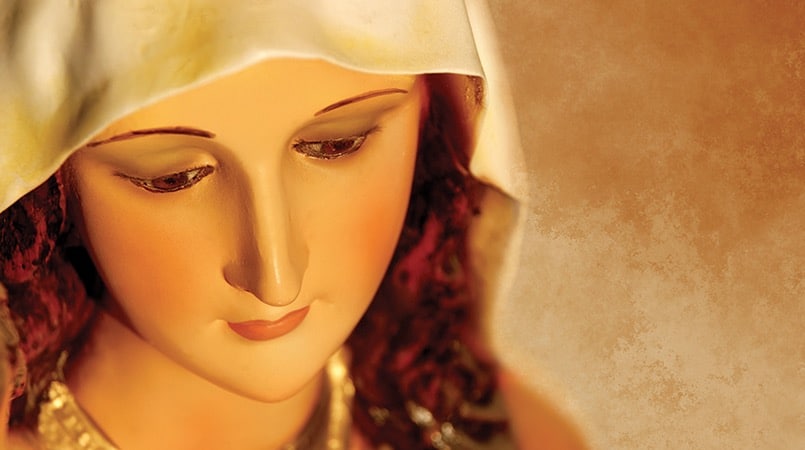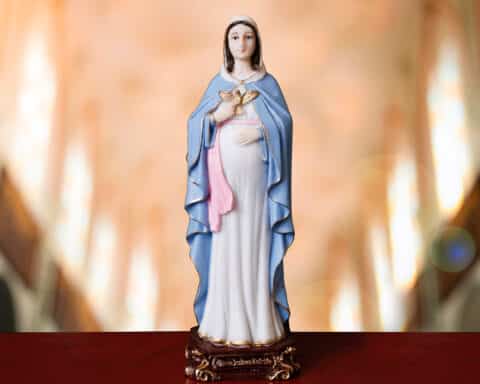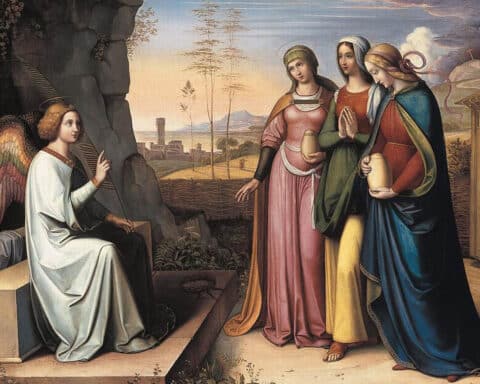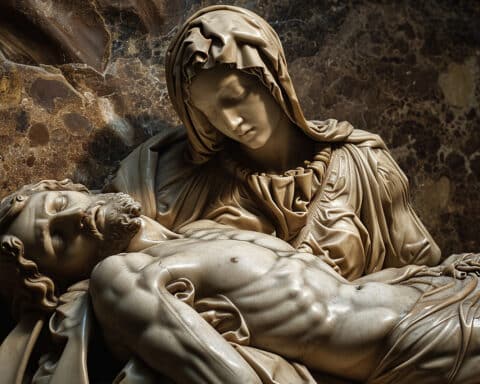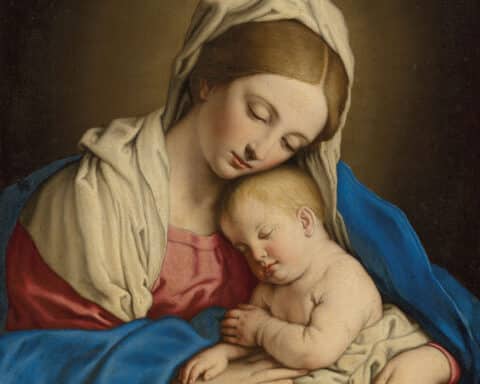Mary, says St. Ambrose, is “the type (today we might say “icon”) of the Church.” In other words, if you want to see a sort of miniature figurine of everything the Church is, look at Mary.
That is why the Church has always venerated Mary and urged us to contemplate her. She can do something that Jesus Christ, God though he is, cannot do: He cannot show us what a disciple of Jesus looks like. Only a disciple of Jesus can do that. And Mary is the greatest disciple Jesus ever had.
What about all the other disciples? Well, as we saw in the first of this series, disciples like Peter, while great, show what imperfect followers are like. But Mary does instantly and perfectly what the rest of us schlubs do haltingly and with a lot of sins and mistakes. As a young girl, probably about 15 years old, she looks level into the eyes of an angel and proclaims, “May it be done to me according to your word” (Lk 1:38).
Full of grace
Some people think a perfect disciple is one who would not need a savior, especially when the Church teaches that Mary is sinless. But Mary herself tells us that her “spirit rejoices in God my Savior” and the Church has prayed those words along with her for 2,000 years (Lk 1:47). The paradox this points to is not that Mary lived on cloud nine and never dealt with any of the troubles we have, but that Mary is the most saved person who ever lived. The grace she was full of made it possible for her to endure a lifetime of poverty, toil, sorrow and ultimately horror. She’s been through the worst any mother could endure. The last wound Christ suffered — the spear through his heart — was endured by her, not him, since he was already dead. A sword truly pierced her soul, as was foretold (Lk 2:35).
| ‘Redemptoris Mater’ |
|---|
|
“Mary is present in the Church as the Mother of Christ, and at the same time as that Mother whom Christ, in the mystery of the Redemption, gave to humanity in the person of the Apostle John. Thus, in her new motherhood in the Spirit, Mary embraces each and every one in the Church, and embraces each and every one through the Church. In this sense Mary, Mother of the Church, is also the Church’s model. Indeed, as Paul VI hopes and asks, the Church must draw ‘from the Virgin Mother of God the most authentic form of perfect imitation of Christ.'” — Pope St. John Paul II in Redemptoris Mater (“Mother of the Redeemer), No. 47
|
But she also shared fully in the ecstasy and joy of the Resurrection. And when her time came, she experienced the Assumption, body and soul into heaven, both as the proper reward for her fidelity and as a sort of down payment and prophecy of the reward we shall all receive if we follow her path of discipleship after Jesus.
That is why the Church of Mary is the Church of discipleship. Pope St. John Paul II once suggested that the “Marian profile” is the most fundamental in the Church. Mary’s “yes” made possible the incarnation of the Son of God. And everything else, including Peter and the Church of office, flows from that. John Paul II said the “Marian profile” in the Church is even “more … fundamental” than the “Petrine profile.” He insisted that the Church formed in Mary’s image — the Church of discipleship — precedes and makes possible the Church of Peter. As the icon of the Church, she shows us what the Church is, how we should live and what our destiny is. For this reason, “the Marian profile is … pre-eminent,” and the Church of Peter exists solely “to form the Church in line with the ideal of sanctity already programmed and prefigured in Mary.” He quoted Hans Urs von Balthasar (who first posited the four models of the Church):
“A contemporary theologian has well commented: ‘Mary is “Queen of the Apostles” without any pretensions to apostolic power; she has other and greater powers.'”
‘You have been called’
Those “other and greater powers” are something we as disciples need to meditate on, as we often afflict ourselves with a false picture of the Church called “clericalism.” Clericalism is the notion that only the ordained and religious are “real” Catholics. It is an idea the Church flatly rejects. All the baptized are members of the Body of Christ. That does not, of course, turn the Church into a populist democracy or a doctrinal free-for-all, but it does make clear that, in the words of Sherry Weddell, “If you are called, you are gifted; and if you are gifted, you have been called.”
Or as St. Paul put it: “And he gave some as apostles, others as prophets, others as evangelists, others as pastors and teachers, to equip the holy ones for the work of ministry, for building up the Body of Christ, until we all attain to the unity of faith and knowledge of the Son of God” (Eph 4:11-13).
In short, the Church of Peter is not the “real” Church in contradistinction to the rest of us. Rather, it performs the vital function of helping us use the many gifts and charisms (as many as there are baptized Catholics). And every single one of us is vitally needed to fulfill the mission of the Church. It’s all hands on deck. At the altar and in the sanctuary, the priest presides, ministering the sacraments to the laity so that we can grow spiritually in sacramental grace and in the knowledge of the word of God.
Mary as our guide
But in the world, we — we the Marian Church of discipleship — preside. We walk out at the end of Mass as living tabernacles, and it is we — very often we alone — who are the sacramental presence of Christ to family, co-workers, friends, homeless people, disgruntled customers, heart-attack victims, noisy kids, gloomy teens, students, old people and total strangers.
Now, we cannot give what we do not have. If we are not disciples, we cannot be apostles, “sent ones.” Therefore the task of discipleship is fundamental. And Mary is our pole star. She stays where she is — adoring Jesus, modeling discipleship and praying for us as our Mother — and we move toward her.
John shows us this by emphasizing both the nuptial and motherly dimension of Mary as the icon of the Church. “Nuptial” sounds weird to us, of course, since Mary is Jesus’ mother, not his wife. But John is using mystical, not literal, language. Jesus begins his ministry with a sign given at the wedding of Cana (Jn 2:1-11). And when you turn the page to John 3, you discover John the Baptist saying, basically, “I’m not the bridegroom. Jesus over there in Chapter 2 is the bridegroom. I’m just the best man.” And when the Gospel reaches its climax at the Crucifixion, John the Evangelist (and he alone) is careful to mention two details: 1) that Jesus’ side was pierced, issuing in blood and water; and 2) that Mary was standing at the foot of the cross. Why?
Because Jesus, the last Adam, is pouring out the water of baptism to create the new Eve — the Church — just as the first Eve was made from the side of the first Adam. And Mary is the icon of that Bride who is the Church.
Not coincidentally, John also records Jesus telling the Beloved Disciple (that is, all of us) “Behold your mother” and saying to her, “Behold your son” (Jn 19:26-27). That is, Jesus makes her not merely a model but the last gift he gives us before leaving this life. She is our mother and not merely our role model. We are involved with her life and she with ours — right now — and are not merely looking at it as a museum piece from antiquity.
A model witness
A disciple is one who is a follower of Jesus. You do not follow somebody who is standing still. Jesus, even in his moments of solitude and stillness, was never standing still. His life was a march to Calvary and, beyond that, to resurrection and ascension.
Mary understood everything Jesus was doing during his earthly life no more than the apostles. She asked questions — as in the incident where she lost him at the age of 12 (Lk 2:41-51). But as a disciple does, she pondered such things in her heart, storing up the memories and trusting that God would make it clear in his time. She never left his side in her heart, even in those times when he left her side in body — and in death.
And that is the essence of discipleship in Christ. You stay with him.
Mark Shea writes from Washington.

